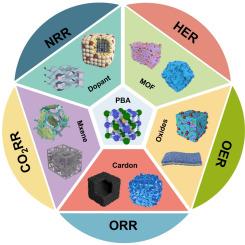电化学能量转换用普鲁士蓝类似物及其衍生物
IF 23.5
1区 化学
Q1 CHEMISTRY, INORGANIC & NUCLEAR
引用次数: 0
摘要
普鲁士蓝类似物(PBAs)作为一类结构可调的多孔材料,由于其结构可调、活性位点丰富、化学稳定性强等优点,在电催化领域引起了越来越多的关注。然而,它们固有的低导电性和催化位点的有限利用继续阻碍着它们的大规模实际应用。本文综述了近年来在提高PBAs电催化性能的结构工程策略方面的研究进展,包括杂原子掺杂、复合结构构建和纳米级设计。特别强调的是阐明结构修饰和催化活性之间的内在关系。此外,系统地讨论了各种pba基材料在析氢反应(HER)、析氧反应(OER)、氧还原反应(ORR)和二氧化碳还原反应(CO2RR)等关键电催化过程中的潜在机理和性能增强策略。最后,综述强调了结构优化在推动绿色能源转换和存储应用的PBAs发展方面的潜力。本文章由计算机程序翻译,如有差异,请以英文原文为准。


Prussian blue analogues and their derivatives for electrochemical energy conversion
As a class of structurally tunable porous materials, Prussian blue analogs (PBAs) have attracted increasing interest in electrocatalysis due to their tunable structures, abundant active sites, and robust chemical stability. Nevertheless, their inherently low conductivity and limited utilization of catalytic sites continue to impede their large-scale practical applications. This review comprehensively summarizes recent advances in structural engineering strategies designed to enhance the electrocatalytic performance of PBAs, including heteroatom doping, composite architecture construction, and nanoscale design. Particular emphasis is placed on elucidating the intrinsic relationship between structural modifications and catalytic activity. Furthermore, the underlying mechanisms and performance enhancement strategies of various PBA-based materials are systematically discussed across key electrocatalytic processes, including the hydrogen evolution reaction (HER), oxygen evolution reaction (OER), oxygen reduction reaction (ORR), and carbon dioxide reduction reaction (CO2RR). Finally, the review highlights the potential of structure optimization in driving the development of PBAs for green energy conversion and storage applications.
求助全文
通过发布文献求助,成功后即可免费获取论文全文。
去求助
来源期刊

Coordination Chemistry Reviews
化学-无机化学与核化学
CiteScore
34.30
自引率
5.30%
发文量
457
审稿时长
54 days
期刊介绍:
Coordination Chemistry Reviews offers rapid publication of review articles on current and significant topics in coordination chemistry, encompassing organometallic, supramolecular, theoretical, and bioinorganic chemistry. It also covers catalysis, materials chemistry, and metal-organic frameworks from a coordination chemistry perspective. Reviews summarize recent developments or discuss specific techniques, welcoming contributions from both established and emerging researchers.
The journal releases special issues on timely subjects, including those featuring contributions from specific regions or conferences. Occasional full-length book articles are also featured. Additionally, special volumes cover annual reviews of main group chemistry, transition metal group chemistry, and organometallic chemistry. These comprehensive reviews are vital resources for those engaged in coordination chemistry, further establishing Coordination Chemistry Reviews as a hub for insightful surveys in inorganic and physical inorganic chemistry.
 求助内容:
求助内容: 应助结果提醒方式:
应助结果提醒方式:


